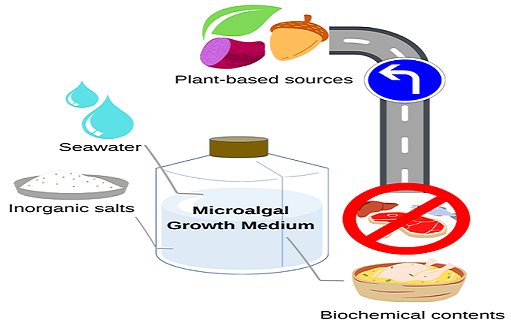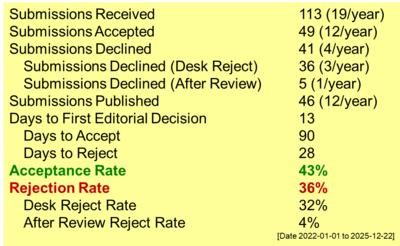Evaluation of The Biochemical Contents in Guillard f/2 and Walne Growth Medium to Fulfill the Animal-Free Aspects of Microalgal Bioprocessing
DOI:
https://doi.org/10.55749/ijcs.v1i2.16Keywords:
Marine microalga, Algal bioprocessing, Animal-free product, Guillard f/2, WalneAbstract
Marine microalgae with their diverse biomolecule contents could be used as potential sources of food, cosmetics, and pharmaceutical ingredients. In accordance with regulations in some countries and to competitively engage huge numbers of consumers, microalgae-based products should be properly manufactured using non-animal-derived materials. As a cultivable microorganism using a scalable bioreactor technique, consideration of the origin of the material used in the upstream process of marine microalgae was inevitable. Currently, the material origin of chemical contents within common artificial microalgal seawater medium had not been evaluated. This article evaluated Guillard f/2 and Walne medium as common artificial microalgal nutrients used in marine microalgal bioprocess-related activities. The risk assessment results showed that the largest portion of Guillard f/2 and Walne media were inorganic salts considered as low, while the remaining biochemical contents of vitamins were categorized as high risk due to their relatively complex chemical synthesis and enzymatic stages during the manufacturing process. As a suggestion, several plant-based bioproducts were proposed as alternative sources to substitute related biochemical actions to fulfill non-animal-origin aspects in the initial stages of the bioprocessing of marine microalgal-based products.
References
Regenstein, J.M., Chaudry, M.M., & Regenstein, C.E. 2003. The kosher and halal food laws. Compr. Rev. Food Sci. Food Saf., 2(3), 111-127. doi: 10.1111/j.1541-4337.2003.tb00018.x. https://doi.org/10.1111/j.1541-4337.2003.tb00018.x
Kenigsberg, J.A., & Zivotofsky, A.Z. 2019. A Jewish religious perspective on cellular agriculture. Front. Sustain. Food Syst. 3 59. doi: 10.3389/fsufs.2019.00128. https://doi.org/10.3389/fsufs.2019.00128
Muhammad, K.M.L., Ariffin, F., Abd Razak, H.K.B., & Sulaiman, P.D.S. 2016. Review of fish gelatin extraction, properties and packaging applications. Food Sci. Nutr. 56. 47-59.
Nitsuwat, S., Zhang, P., Ng, K., & Fang, Z. 2021. Fish gelatin as an alternative to mammalian gelatin for food industry: A meta-analysis. LWT. 141. 110899. doi: 10.1016/j.lwt.2021.110899. https://doi.org/10.1016/j.lwt.2021.110899
Derkach, S.R., Voron'ko, N. G., Kuchina, Y. A., & Kolotova, D.S. 2020. Modified fish gelatin as an alternative to mammalian gelatin in modern food technologies. Polymers. 12(12). 3051. doi: 10.3390/polym12123051. https://doi.org/10.3390/polym12123051
Karim, A. A., & Bhat, R. 2009. Extraction and characterization of gelatin from Atlantic salmon (Salmo salar) skin. Food Hydrocoll. 23(3). 563-576. doi: 10.1016/j.foodhyd.2008.07.002. https://doi.org/10.1016/j.foodhyd.2008.07.002
Zaky, A.S., Greetham, D., Tucker, G.A. and Du, C. 2018. The establishment of a marine focused biorefinery for bioethanol production using seawater and a novel marine yeast strain. Sci. Rep. 8(1). 1-14. doi: 10.1038/s41598-018-30660-x. https://doi.org/10.1038/s41598-018-30660-x
Souza, F.A.S.D., Salgueiro, A.A. and Albuquerque, C.D.C. 2012. Production of bioemulsifiers by Yarrowia lipolytica in sea water using diesel oil as the carbon source. Braz. J. Chem. Eng. 29(1). 61-67. doi: 10.1590/S0104-66322012000100007. https://doi.org/10.1590/S0104-66322012000100007
Sarkar, S., Pramanik, A., Mitra, A. and Mukherjee, J. 2010. Bioprocessing data for the production of marine enzymes. Mar. Drugs. 8(4). 1323-1372. doi: 10.3390/md8041323. https://doi.org/10.3390/md8041323
Kim, Z. H., Park, H., & Lee, C. G. 2016. Seasonal assessment of biomass and fatty acid productivity by Tetraselmis sp. in the ocean using semi-permeable membrane photobioreactors. J. Microbiol. Biotechnol. 26(6). 1098-1102. doi: 10.4014/jmb.1601.01031. https://doi.org/10.4014/jmb.1601.01031
Stiawan, E., Rachmawati, Y., Nurachman, Z., Sutomo, S., & Sapulete, S. 2022. Identification of Tropical Marine Diatom Chaetoceros dayaensis CBO from Bokor Island through Morphology and Genetic Marker Analysis. Indones. J. Chem. Stud. 1(1). 1-7. doi: 10.55749/ijcs.v1i1.2. https://doi.org/10.55749/ijcs.v1i1.2
Keputusan Menteri Agama Republik Indonesia No. 1360 Tahun 2021 Tentang Bahan yang dikecualikan dari kewajiban bersertifikat Halal.
Kirk, R.E., Othmer, D.F., & Eckroth,D. 2004. Encyclopedia of Chemical Technology Vol. 5. John Wiley & Sons, Inc.
Wisniak, J. and Garcés, I., 2001. The rise and fall of the salitre (sodium nitrate) industry. Indian J. Chem. Technol. 8(9). 427-438. doi: 10.1016/S0966-842X(01)02130-8. https://doi.org/10.1016/S0966-842X(01)02130-8
Jiang, M., Liu, M., Huang, H., & Chen, F. 2021. Fully Continuous Flow Synthesis of 5-(Aminomethyl)-2-methylpyrimidin-4-amine: A Key Intermediate of Vitamin B1. Org. Process. Res. Dev. 25(10). 2331-2337. doi: 10.1021/acs.oprd.1c00253. https://doi.org/10.1021/acs.oprd.1c00253
Chaudry, M.M., 2022. Halal Product Certificate (Report No. 4739.15720.II220009, pp. 1-99). The Islamic Food and Nutrition Council of America (IFANCA). https://www.sigmaaldrich.com/deepweb/assets/sigmaaldrich/product/documents/396/950/halal_certificate.pdf
Seki, M. 2006. Biological significance and development of practical synthesis of biotin. Med. Res. Rev. 26(4). 434-482). doi: 10.1002/med.20058. https://doi.org/10.1002/med.20058
Seki, M. 2008. (+)-Biotin: A Challenge for industrially viable total synthesis of natural products. Stud. Nat. Prod. Chem. 34(C). 265-307. doi:10.1016/S1572-5995(08)80029-4. https://doi.org/10.1016/S1572-5995(08)80029-4
Calvillo, Á., Pellicer, T., Carnicer, M., & Planas, A. 2022. Bioprocess Strategies for Vitamin B12 Production by Microbial Fermentation and Its Market Applications. Bioengineering. 9(8). 365. doi: 10.3390/bioengineering9080365. https://doi.org/10.3390/bioengineering9080365
Fitzpatrick, T.B., & Chapman, L.M. 2020. The importance of thiamine (vitamin B1) in plant health: From crop yield to biofortification. J. Biol. Chem. 295(34). 12002-12013. doi: 10.1074/jbc.REV120.010918. https://doi.org/10.1074/jbc.REV120.010918
Kerns, J.C., & Gutierrez, J.L. 2017. Thiamin. In Advances in Nutrition. ASN. 8(2). 395-397). doi:10.3945/an.116.013979. https://doi.org/10.3945/an.116.013979
Lalić, J., Denić, M., Sunarić, S., Kocić, G., Trutić, N., Mitić, S., & Jovanović, T. 2014. Assessment of thiamine content in some dairy products and rice milk. CYTA-J. Food. 12(3). 203-209. doi: 10.1080/19476337.2013.814713. https://doi.org/10.1080/19476337.2013.814713
Hrubša, M., Siatka, T., Nejmanová, I., Vopršalová, M., Krčmová, L. K., Matoušová, K., Javorská, L., Macáková, K., Mercolini, L., Remião, F., Mát'uš, M., & Mladěnka, P. 2022. Biological Properties of Vitamins of the B-Complex, Part 1: Vitamins B1, B2, B3, and B5. Nutrients. 14(3). doi: 10.3390/nu14030484. https://doi.org/10.3390/nu14030484
Niklewicz, A., Smith, A.D., Smith, A., Holzer, A., Klein, A., McCaddon, A., Molloy, A.M., Wolffenbuttel, B.H.R., Nexo, E., McNulty, H., Refsum, H., Gueant, J.L., Dib, M.J., Ward, M., Murphy, M., Green, R., Ahmadi, K.R., Hannibal, L., Warren, M.J., & Owen, P.J. 2022. The importance of vitamin B12 for individuals choosing plant-based diets. Eur. J. Nutr. doi: 10.1007/s00394-022-03025-4. https://doi.org/10.1007/s00394-022-03025-4
Watanabe, F., Yabuta, Y., Bito, T., & Teng, F. 2014. Vitamin B12-containing plant food sources for vegetarians. Nutrients. 6(5). 1861-1873. doi: 10.3390/nu6051861. https://doi.org/10.3390/nu6051861
Chandra-Hioe, M.V., Lee, C. and Arcot, J., 2019. What is the cobalamin status among vegetarians and vegans in Australia?. Int. J. Food Sci. Nutr. 70(7). 875-886. doi: 10.1080/09637486.2019.1580681. https://doi.org/10.1080/09637486.2019.1580681
Jungert, A., Ellinger, S., Watzl, B., & Richter, M. 2022. Revised D-A-CH reference values for the intake of biotin. Eur. J. Nutr. 61(4). 1779-1787. doi: 10.1007/s00394-021-02756-0. https://doi.org/10.1007/s00394-021-02756-0
Watanabe, T., Kioka, M., Fukushima, A., Morimoto, M. and Sawamura, H. 2014. Biotin content table of select foods and biotin intake in Japanese. Int. J. Anal. Bio-Sci. 2(4). 109-125.
Ishida, H., Suzuno, H., Sugiyama, N., Innami, S., Tadokoro, T. and Maekawa, A. 2000. Nutritive evaluation on chemical components of leaves, stalks and stems of sweet potatoes (Ipomoea batatas poir). Food Chem. 68(3). 359-367. doi: 10.1016/S0308-8146(99)00206-X. https://doi.org/10.1016/S0308-8146(99)00206-X
Agostoni, C., Canani, R.B., Fairweather-Tait, S., Heinonen, M., Korhonen, H., La Vieille, S., Marchelli, R., Martin, A., Naska, A., Neuhaeuser-Berthold, M. and Nowicka, G. 2014. Scientific Opinion on Dietary Reference Values for zinc. Efsa Journal, 12(10). 3844. doi: 10.2903/j.efsa.2014.3844. https://doi.org/10.2903/j.efsa.2014.3844

Downloads
Published
How to Cite
Issue
Section
License
Copyright (c) 2022 Indonesian Journal of Chemical Studies

This work is licensed under a Creative Commons Attribution-ShareAlike 4.0 International License.






















